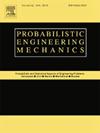Quantitative property of MF-discrepancy and efficient point-selection strategy for the nonlinear stochastic response analysis of structures with random parameters
IF 3.5
3区 工程技术
Q2 ENGINEERING, MECHANICAL
引用次数: 0
Abstract
The response analysis of high-dimensional and strongly nonlinear systems with random parameters remains a significant challenge in stochastic computational mechanics. To address this challenge, some methods based on the high-efficacy point sets have been developed, in which efficient global-point-set methods represented by low-discrepancy are of paramount importance in generating representative point sets. Several discrepancies including the extended F-discrepancy (EF-discrepancy) and the generalized F-discrepancy (GF-discrepancy) have been introduced to assess the uniformity and the efficacy of a representative point set. In such context, a maximal marginal EF-discrepancy (MF-discrepancy), which is an extended form of the GF-discrepancy, is proposed in this paper and then the properties of the MF-discrepancy are studied in detail. The probability distribution of the MF-discrepancy is derived, including a rigorous proof for random point sets and a model based on an assumption for some generic point sets. A generalized Koksma-Hlawka inequality is established accordingly to govern the worst error estimate. The lowest bound of the MF-discrepancy is given, and two intuitive quantitative indices are proposed to measure the goodness of the MF-discrepancy. Based on the lowest bound, an enhanced point-selection strategy with a unified theoretical framework for minimizing the MF-discrepancy is proposed. In this framework, locally minimizing the MF-discrepancy yields the two-step point-selection method, and a new point-selection strategy is proposed based on the global minimization of the MF-discrepancy, which is verified to be efficient and robust, especially in high-dimensional cases. Several numerical examples, including a 2-story shear frame, a 10-story shear frame, and a 10-story reinforced concrete frame structure modeled by the finite element method, are studied, verifying the efficiency and the robustness of the proposed point-selection strategy.
随机参数结构非线性随机响应分析的中频差异定量特性和高效选点策略
对具有随机参数的高维强非线性系统进行响应分析,仍然是随机计算力学领域的一项重大挑战。为了应对这一挑战,人们开发了一些基于高效点集的方法,其中以低差异为代表的高效全局点集方法对生成代表性点集至关重要。为了评估代表性点集的均匀性和有效性,引入了几种差异,包括扩展 F-差异(EF-差异)和广义 F-差异(GF-差异)。在此背景下,本文提出了最大边际 EF-差异(MF-差异),它是 GF-差异的扩展形式,然后详细研究了 MF-差异的特性。本文推导了 MF-差异的概率分布,包括随机点集的严格证明和基于一些通用点集假设的模型。据此建立了广义的 Koksma-Hlawka 不等式,以控制最差误差估计。给出了中频差异的最低界限,并提出了两个直观的量化指标来衡量中频差异的好坏。在最低界限的基础上,提出了一种具有统一理论框架的增强型选点策略,以最小化中频差异。在这一框架中,局部最小化中频差异产生了两步选点法,并基于中频差异的全局最小化提出了一种新的选点策略,该策略被证实是高效和稳健的,尤其是在高维情况下。研究了几个数值实例,包括一个 2 层剪力框架、一个 10 层剪力框架和一个用有限元法建模的 10 层钢筋混凝土框架结构,验证了所提出的选点策略的效率和鲁棒性。
本文章由计算机程序翻译,如有差异,请以英文原文为准。
求助全文
约1分钟内获得全文
求助全文
来源期刊

Probabilistic Engineering Mechanics
工程技术-工程:机械
CiteScore
3.80
自引率
15.40%
发文量
98
审稿时长
13.5 months
期刊介绍:
This journal provides a forum for scholarly work dealing primarily with probabilistic and statistical approaches to contemporary solid/structural and fluid mechanics problems encountered in diverse technical disciplines such as aerospace, civil, marine, mechanical, and nuclear engineering. The journal aims to maintain a healthy balance between general solution techniques and problem-specific results, encouraging a fruitful exchange of ideas among disparate engineering specialities.
 求助内容:
求助内容: 应助结果提醒方式:
应助结果提醒方式:


